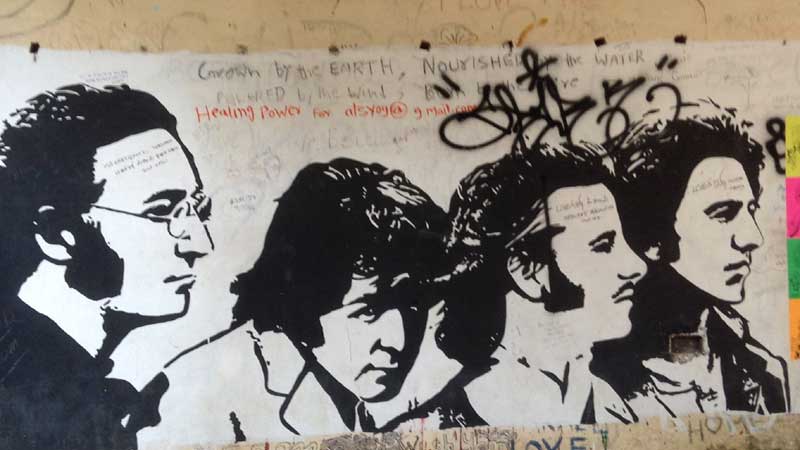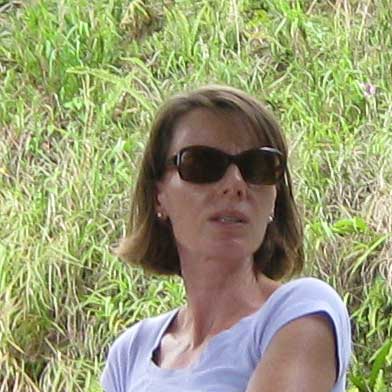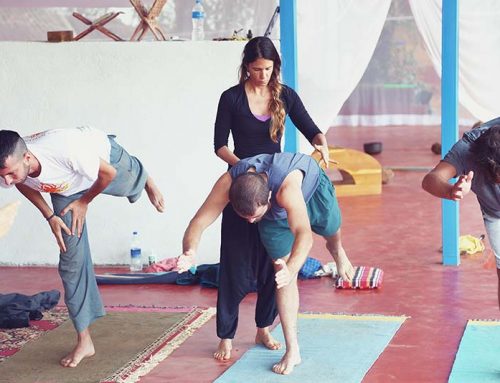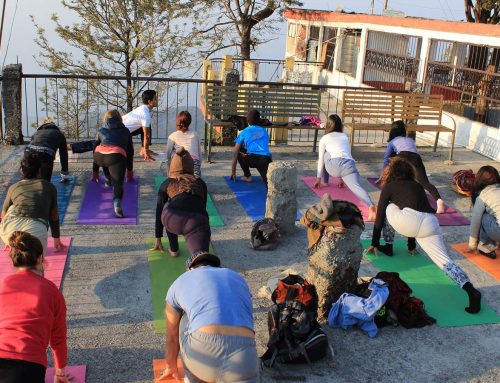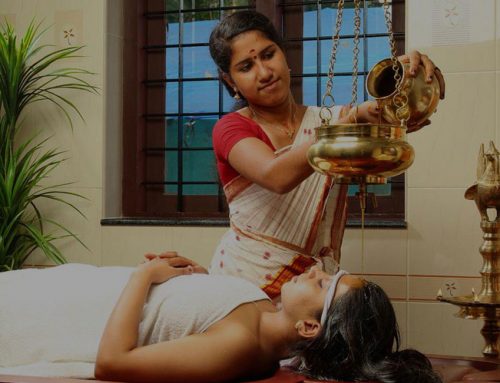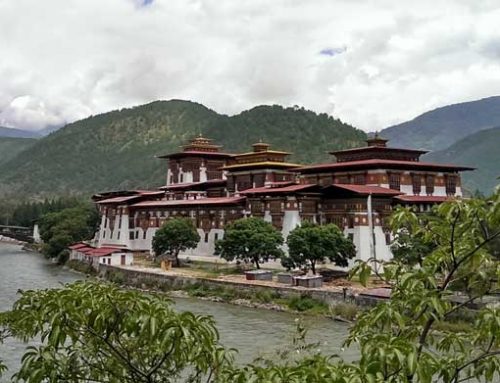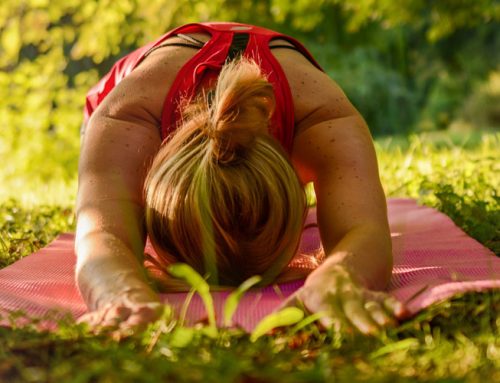By Leslie Smith
“Turn off your mind, relax and float downstream, it is not dying …”
—Tomorrow Never Knows
Fashion, music, culture, spirituality. The Beatles 1968 trip to India was a groundbreaking event across the spectrum of Western pop culture. February, 2018 marks the 50th anniversary of their visit to the Maharishi Mahesh Yogi’s Transcendental Meditation Ashram in Rishikesh. And yes, dear Prudence, the monkeys are still “doing it in the road”—though their vigorous copulation no longer inspires songwriters.
In fact, the ashram has been abandoned for years. Just finding it is an adventure…especially when navigating via a map drawn on a napkin by a yoga instructor at breakfast.

Ganges: On the way to Beatles Ashram
The so-called Beatles Ashram is located at the far end of Swarg Ashram, a sort of suburb of Rishikesh on the less-trafficked bank of the Ganges. Few tourists can even find it, let alone summon up the courage to navigate the narrow, winding streets filled with donkeys, cows (and occasionally randy bulls), maimed beggars, holy men hustling for a meal, and pilgrims bathing on the Ghats of the sacred Ganges. Walk by the Last Chance Cafe & Guest House, pass a series of tin huts where a woman forcibly ejects a cow from her hovel, and shinny around the end of a wall. Walk along a ledge and over a rocky riverbed that was once a road before floods destroyed it. Dead ahead are a troupe of monkeys, sitting primly on a wall but ready to…uh…do it in the road, given the slightest provocation.
“He went out tiger hunting with his elephant & gun; in case of accidents he always took his mum…”

John Lennon mural, Beatles Ashram
The ashram is now part of the Rajaji Tiger Reserve and plans are afoot to refurbish part of the sprawling compound as a museum and tourist attraction. The long and winding road to the compound wends upward past conical meditation huts made of river stone, overlooking a very holy part of the Ganges. Today, the grounds have nearly returned to jungle, with spiders as big as my hand hanging in webs over the doorways, trees poking through courtyards—as well as the possibility of encounters with tigers, elephants, deer and 47 other species of animals, and the 300 different types of birds that live within the far-flung park boundaries.
But back in the 60s, the extensive site was throbbing with life. Toronto’s Emmy-award-winning film/TV director-producer Paul Saltzman was there with the Beatles—and took many moving, intimate photos of the Fab Four. The Beatles still rank as one of the most popular bands in the world and a key musical ancestor of countless bands from Pink Floyd to Alt-J, The xx and Tame Impala.

Beatles Cave, Beatles Ashram
Saltzman’s reminiscences about where, when and how his week-long encounter happened are priceless: “Their music changed my life and the content of what they said was life-changing for me.”
Across the Universe
The Beatles’ Indian experience created a new openness to world music, and put India on the map as an enduringly hip and groovy place to examine our spirituality, learn meditation and yoga. The Beatles shopped in Rishikesh, known then and now as “the yoga capital of the world”; saris were purchased and worn by the women—and made into shirts and jackets for the men by the Maharishi’s on-site tailor. When the Beatles wore their new outfits home, Western fashion was changed forever. Soon, everyone knew what a sitar was.
And 50 years later, we’re still going back for more.

Beatles group mural, Beatles Ashram
Some of Saltzman’s iconic photos will be used in a new Beatles museum planned for the ashram site which could get the go-ahead as early as Dec. 15, 2017. A hardcover limited edition of Saltzman’s book of photos, The Beatles in India will be out in February. Pattie Boyd, George Harrison’s first wife, has written a new introduction; the book contains some of the most intimate photographs ever taken of the Fab Four. Saltzman was the only “outsider” to gain access to the Beatles’ during their time there.
Writes Boyd, “As a photographer myself, I wish I had shot more photos while I was there with the band. But I made a conscious decision at the time to not be intrusive. I felt that the whole thing was very special, very peaceful, a retreat from the world of cameras. I think Paul Saltzman may have had a similar feeling and tried to be as non-intrusive as possible. We were all taking our own personal spiritual journeys and I felt that what we learned at the ashram was just for the people that were there. I didn’t think globally, I didn’t think that time was for everybody. But, now, ironically, I want everyone to know about it. It’s a testimony to how time changes us.”
Day Tripper, Yeah

Long Road, Beatles Ashram
Time has certainly changed Chaurasi Kutia Ashram. Creeping through piles of debris and over the trailing roots of trees and drooping leaves of huge plants, it is difficult even to breathe in the high humidity of the day. There is barely a soul around though the ashram must have once housed hundred, training disciples in a form of meditation designed to let them free their minds—and find peace.
Yet it was here the Beatles’ White Album and Abbey Road were born— albums which changed rock music forever. While there, the Beatles wrote 48 songs — with Mike Love of the Beach Boys, Donovan and others—including Don’t Pass Me By, Back in the U.S.S.R., Blackbird, Dear Prudence, Bungalow Bill and Why Don’t We Do It In The Road?, Paul’s homage to the ashram’s highly-sexed monkeys. Mia Farrow’s sister Prudence meditated up to 12 hours a day and would not “come out and play”—as chronicled in the song, Dear Prudence.
Harrison celebrated his 25th birthday there, and was so into meditation that Lennon quipped, “The way George is going, he’ll be flying a magic carpet by the time he’s forty.”(1)
But it is the many colourful Beatles-related murals painted on the deserted buildings that bring the ashram to life. Murals depict imaginary scenes from song such as Blackbird, While My Guitar Gently Weeps, Yellow Submarine, and many more. But it was in a deserted meditation hall that I finally found what I had been searching India for. On a raised plinth the words Let It Be were inscribed on a black and white background. It was that simple. Let it be.
After Several Hard Days’ Nights, Paul Saltzman Meets The Beatles

Let it Be Beatles Ashram
In early 1968 Saltzman was in India filming a documentary. He was 24 and, like most of the world, a Beatles fan. Life was good—until suddenly it wasn’t.
“I had just received a letter from my beloved girlfriend in Toronto saying she had moved in with Henry and I was devastated. I went to the ashram to learn meditation in the hopes that it would help heal the pain of a broken heart. I didn’t know the Beatles would be there until I got to the gates of the ashram.
Saltzman headed north to Chaurasi Kutia Ashram, run by the world-famous Maharishi. “I waited outside the gates for eight days to get in. It was not to meet them. It was not good news that they were there, even though I was a fan. The first eight days for me were simply sleeping in a tent outside the ashram and waiting (because the ashram was closed to the public). Every day there was major press action. The Beatles were among the most famous people in the planet and that they had disappeared into an ashram was puzzling and consternating to some—and a news story.”
Twenty to thirty journalists would congregate outside the ashram gates every day but were told the same thing: the ashram was closed to the public, say Saltzman. “The maharishi would come out every day and give a press conference under a tree every day not far from the tent where I was staying.”
The Magical, Mini Maharishi Tour

Holy cow Beatles Ashram
The diminutive Maharishi died on February 6, 2008 at his headquarters in The Netherlands; 2018 may also mark the 100th anniversary of his birth (the actual date is uncertain). The Maharishi was arguably more famous amongst Indians than the Beatles. Indian tourists still come to see the ashram where he taught his famous brand of meditation. Cosmic consciousness could be achieved through the good vibrations generated by chanting mantras and meditating in half-hour sessions twice daily—for a suggested fee of a week’s salary. The goal was to get rid of impure thoughts and achieve oneness with the universe.
In the 1980s, the Maharishi’s followers gave touring demonstrations of yogic flying in an effort to raise awareness for global peace; I witnessed one of the demonstrations in Halifax which involved a very athletic form of hopping while cross-legged. Only after I took up yoga did I realize how remarkable the demonstration was. The Maharishi’s empire grew to include a 24-hour satellite TV channel broadcasting in 22 languages to 144 countries, books, CDs, a property company, universities, charitable trusts, headquarters on five continents.
By the 90s the movement had aligned itself with the Natural Law Party, led in Canada by magician Doug Henning—promising heaven on earth and possibly lower taxes. And what’s wrong with that? I even voted for them in 1993, when they ran 231 candidates in the federal election. The heaven-on-earth idea isn’t so crazy: seekers of all ages still flock to India with the same goal in mind. Saltzman himself will soon make what he estimates to be his 57th or 58th trip to India next fall when he leads a group tour to Rishikesh.
Meanwhile Back in the Beatles Ashram: Don’t Know How Lucky You Are, Boy

Tree in residence Beatles Ashram
Eventually, Saltzman was allowed through the gates, after an ashram official, who visited him every day, learned his story and took pity on him. “Once I was allowed in the ashram,” Saltzman remembers, “I had my meals with
There were 13 or so “famous folk” in the group, Saltzman recalls: George Harrison and Pattie Boyd, Paul McCartney and Jane Asher, John and Cynthia Lennon, Ringo and Maureen Starr, Mia Farrow, Mal Evans (the Beatles roadie and trusted right-hand man), Donovan Leitch and Mike Love of the Beach Boys. Prudence Farrow (Mia’s sister, who inspired the song Dear Prudence) and Jennie Boyd (Pattie’s sister, who later married Mick Fleetwood and about whom Donovan had already written the song Jennifer Juniper), were taking an intensive TM teaching course with the Maharishi—joining the group later in the day.
“Travellers went to India looking for spiritual content going back centuries and centuries but it wasn’t a very common thing from the West. Certainly the Beatles and the publicity that came out of it, and the enormous following that they had is responsible for (the huge influence of Indian culture, yoga meditation, music, fashion in the world today),” says Saltzman. “The Western interest in all of that, and going to india, really stemmed from the Beatles time there and all of the coverage” of yoga, meditation, ayurvedic healing and spirituality. Some people feel that the whole western openness to world music—the birth of world music in the West—started with George Harrison picking up the sitar on the set of Help!”

Meditation Huts at Beatles Ashram
Harrison’s subsequent friendship with Indian sitar whiz Ravi Shankar led them to collaborate on the never-before-done Concert for Bangladesh billed as “George Harrison & Friends”—Bob Dylan, Ringo Starr, Eric Clapton, Billy Preston, Leon Russell, Badfinger and others. The event—which spun off a live-album, boxed three-record set and a concert documentary—spawned a whole benefit concert industry leading to humanitarian relief events like Live Aid, Farm Aid and Live 8.
“Their music changed my life and the content of what they said was life changing for me,” Saltzman notes. “I had never heard of the concept of ‘turn off your mind, relax and float downstream, it is not dying’…and ‘go towards the void.’ When I first heard (the lyrics from Lennon’s Tomorrow Never Knows) I thought ‘what are they talking about?’ That was the birth for me of seeking an inner depth to life as opposed to only the outer.”
“But the bottom line is you don’t need to go anywhere to find what is inside you.”
“The truth,” says Saltzman, is ”between you and your connection with Divine Presence. It’s really available for you, me and anybody else for free. You can do that anywhere in the world.”
The Beatles’ Ashram may soon be renovated into a real tourist attraction, says Saltzman, who is waiting for word on the outcome of a meeting Dec. 15 between Rajaji Tiger Preserve officials examining architects’ drawings of proposed improvements.
The ashram “is a historic site in several ways: one for Beatles fans; it also has great significance in the Beatles’ lives because it was George’s intent to go deeper into meditation and inner peace, as it was John’s and to an extent Paul and Ringo. It was their single most creative capsule of time,” says Saltzman “They wrote 48 songs in less than seven weeks and I think that is pretty stunning. It had to do with quiet and meditation, and a space for creativity.”
Fixing a Hole Where the Rain Comes In

Yellow Submarine, Beatles Ashram
“I think the government fixing up the ashram is a lovely way for them to promote a little more tourism and get a little more revenue. I think it is good that they fix up the ashram so the location has a little more historical content. I am going to donate some of my pictures for a kind of museum or gallery with information on the Maharishi and meditation and the Beatles and their visit there.”
Saltzman didn’t take the only pictures of the group inside the ashram. Some of the Beatles and their partners and friends had cameras, including Ringo, Pattie Boyd and Mal Evans. When he took a formal group picture of everyone with the Maharishi, the others wanted one as well. “I had four cameras around my neck—mine and theirs.”
(1)Quoted in Joshua M. Greene’s 2008 book, Here Comes the Sun: The Spiritual and Musical Journey of George Harrison (John Wiley & Sons).
(Photos and Story Copyright Leslie Smith 2017)

